(All information courtesy of the instrument teams.)
![]() Previous IAU Circulars
Previous IAU Circulars
TITLE: GCN/SWIFT NOTICE
NOTICE_DATE: Mon 10 Mar 08 08:38:20 UT
NOTICE_TYPE: Swift-BAT GRB Position
TRIGGER_NUM: 305288, Seg_Num: 0
GRB_RA: 220.081d {+14h 40m 19s} (J2000),
220.186d {+14h 40m 45s} (current),
219.440d {+14h 37m 46s} (1950)
GRB_DEC: -0.166d {-00d 09' 55"} (J2000),
-0.200d {-00d 12' 00"} (current),
+0.049d {+00d 02' 55"} (1950)
GRB_ERROR: 3.00 [arcmin radius, statistical only]
GRB_INTEN: 5801 [cnts] Image_Peak=215 [image_cnts]
TRIGGER_DUR: 1.024 [sec]
TRIGGER_INDEX: 137 E_range: 15-50 keV
BKG_INTEN: 38006 [cnts]
BKG_TIME: 31061.36 SOD {08:37:41.36} UT
BKG_DUR: 8 [sec]
GRB_DATE: 14535 TJD; 70 DOY; 08/03/10
GRB_TIME: 31078.64 SOD {08:37:58.64} UT
GRB_PHI: 158.26 [deg]
GRB_THETA: 27.79 [deg]
SOLN_STATUS: 0x3
RATE_SIGNIF: 12.60 [sigma]
IMAGE_SIGNIF: 7.40 [sigma]
MERIT_PARAMS: +1 +0 +0 +1 +1 +4 +0 +0 +65 +1
SUN_POSTN: 350.95d {+23h 23m 47s} -3.90d {-03d 54' 07"}
SUN_DIST: 130.63 [deg] Sun_angle= 8.7 [hr] (West of Sun)
MOON_POSTN: 21.89d {+01h 27m 33s} +13.89d {+13d 53' 23"}
MOON_DIST: 157.30 [deg]
MOON_ILLUM: 9 [%]
GAL_COORDS: 351.20, 52.19 [deg] galactic lon,lat of the burst (or transient)
ECL_COORDS: 217.72, 14.68 [deg] ecliptic lon,lat of the burst (or transient)
COMMENTS: SWIFT-BAT GRB Coordinates.
COMMENTS: This is a rate trigger.
COMMENTS: A point_source was found.
COMMENTS: This does not match any source in the on-board catalog.
COMMENTS: This does not match any source in the ground catalog.
COMMENTS: This is a GRB.
COMMENTS: This trigger occurred at longitude,latitude = 267.16,17.76 [deg].
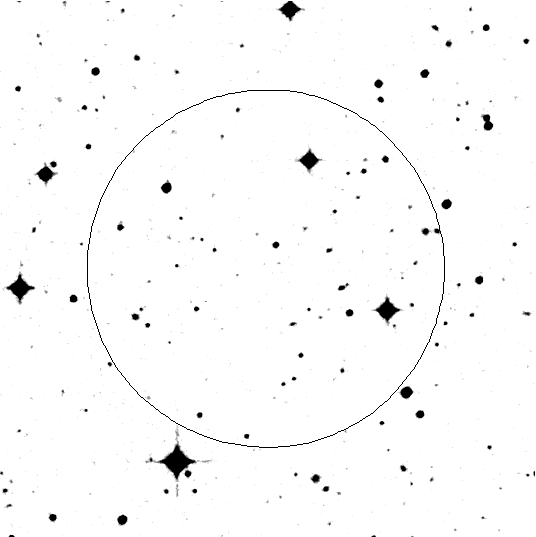
TITLE: GCN/SWIFT NOTICE
NOTICE_DATE: Mon 10 Mar 08 08:39:57 UT
NOTICE_TYPE: Swift-XRT Position
TRIGGER_NUM: 305288, Seg_Num: 0
GRB_RA: 220.0566d {+14h 40m 13.5s} (J2000),
220.1616d {+14h 40m 38.7s} (current),
219.4159d {+14h 37m 39.8s} (1950)
GRB_DEC: -0.1756d {-00d 10' 32.1"} (J2000),
-0.2105d {-00d 12' 37.6"} (current),
+0.0385d {+00d 02' 18.5"} (1950)
GRB_ERROR: 5.0 [arcsec radius, statistical plus systematic, 90% containment]
GRB_INTEN: 1.50e-09 [erg/cm2/sec]
GRB_SIGNIF: 8.12 [sigma]
IMG_START_DATE: 14535 TJD; 70 DOY; 08/03/10
IMG_START_TIME: 31167.85 SOD {08:39:27.85} UT, 89.2 [sec] since BAT Trigger Time
TAM[0-3]: 327.64 237.26 261.35 243.53
AMPLIFIER: 2
WAVEFORM: 134
SUN_POSTN: 350.95d {+23h 23m 47s} -3.90d {-03d 54' 05"}
SUN_DIST: 130.65 [deg] Sun_angle= 8.7 [hr] (West of Sun)
MOON_POSTN: 21.90d {+01h 27m 37s} +13.90d {+13d 53' 47"}
MOON_DIST: 157.33 [deg]
MOON_ILLUM: 9 [%]
GAL_COORDS: 351.16, 52.20 [deg] galactic lon,lat of the burst
ECL_COORDS: 217.70, 14.67 [deg] ecliptic lon,lat of the burst
COMMENTS: SWIFT-XRT Coordinates.
TITLE: GCN/SWIFT NOTICE
NOTICE_DATE: Mon 10 Mar 08 08:40:07 UT
NOTICE_TYPE: Swift-XRT Image
TRIGGER_NUM: 305288, Seg_Num: 0
GRB_RA: 220.0566d {+14h 40m 13.5s} (J2000),
220.1616d {+14h 40m 38.7s} (current),
219.4159d {+14h 37m 39.8s} (1950)
GRB_DEC: -0.1756d {-00d 10' 32.1"} (J2000),
-0.2105d {-00d 12' 37.6"} (current),
+0.0385d {+00d 02' 18.5"} (1950)
GRB_ERROR: 5.0 [arcsec, radius, statistical plus systematic]
GRB_INTEN: 66 [cnts]
IMG_START_DATE: 14535 TJD; 70 DOY; 08/03/10
IMG_START_TIME: 31167.85 SOD {08:39:27.85} UT, 89.2 [sec] since BAT Trigger Time
CENTROID_X: 357.74, raw= 358 [pixels]
CENTROID_Y: 276.83, raw= 277 [pixels]
ROLL: 95.27 [deg]
GAIN: 1
MODE: 3, Long Image mode
WAVEFORM: 134
EXPO_TIME: 2.50 [sec]
GRB_POS_XRT_Y: -49.89
GRB_POS_XRT_Z: 130.69
IMAGE_URL: sw00305288000msxps_rw.img
SUN_POSTN: 350.95d {+23h 23m 47s} -3.90d {-03d 54' 05"}
SUN_DIST: 130.65 [deg] Sun_angle= 8.7 [hr] (West of Sun)
MOON_POSTN: 21.90d {+01h 27m 37s} +13.90d {+13d 53' 50"}
MOON_DIST: 157.33 [deg]
MOON_ILLUM: 9 [%]
GAL_COORDS: 351.16, 52.20 [deg] galactic lon,lat of the burst
ECL_COORDS: 217.70, 14.67 [deg] ecliptic lon,lat of the burst
COMMENTS: SWIFT-XRT Image.

TITLE: GCN/SWIFT NOTICE
NOTICE_DATE: Mon 10 Mar 08 08:40:14 UT
NOTICE_TYPE: Swift-XRT Processed Image
TRIGGER_NUM: 305288, Seg_Num: 0
GRB_RA: 220.0566d {+14h 40m 13.5s} (J2000),
220.1616d {+14h 40m 38.7s} (current),
219.4159d {+14h 37m 39.8s} (1950)
GRB_DEC: -0.1756d {-00d 10' 32.1"} (J2000),
-0.2105d {-00d 12' 37.6"} (current),
+0.0385d {+00d 02' 18.5"} (1950)
GRB_ERROR: 5.0 [arcsec, radius, statistical plus systematic]
GRB_INTEN: 66 [cnts]
IMG_START_DATE: 14535 TJD; 70 DOY; 08/03/10
IMG_START_TIME: 31167.85 SOD {08:39:27.85} UT, 89.2 [sec] since BAT Trigger Time
CENTROID_X: 357.74, raw= 358 [pixels]
CENTROID_Y: 276.83, raw= 277 [pixels]
ROLL: 95.27 [deg]
GAIN: 1
MODE: 3, Long Image mode
WAVEFORM: 134
EXPO_TIME: 2.50 [sec]
GRB_POS_XRT_Y: -49.89
GRB_POS_XRT_Z: 130.69
IMAGE_URL: sw00305288000msxps_rw.img
SUN_POSTN: 350.95d {+23h 23m 47s} -3.90d {-03d 54' 05"}
SUN_DIST: 130.65 [deg] Sun_angle= 8.7 [hr] (West of Sun)
MOON_POSTN: 21.90d {+01h 27m 37s} +13.90d {+13d 53' 51"}
MOON_DIST: 157.33 [deg]
MOON_ILLUM: 9 [%]
GAL_COORDS: 351.16, 52.20 [deg] galactic lon,lat of the burst
ECL_COORDS: 217.70, 14.67 [deg] ecliptic lon,lat of the burst
COMMENTS: SWIFT-XRT Processed Image.

TITLE: GCN/SWIFT NOTICE
NOTICE_DATE: Mon 10 Mar 08 08:41:40 UT
NOTICE_TYPE: Swift-UVOT Source List
TRIGGER_NUM: 305288, Seg_Num: 0
POINT_RA: 220.095d {+14h 40m 23s} (J2000)
POINT_DEC: -0.164d {-00d 09' 50"} (J2000)
POINT_ROLL: 95.272d
IMG_START_DATE: 14535 TJD; 70 DOY; 08/03/10
IMG_START_TIME: 31176.67 SOD {08:39:36.67} UT, 98.0 [sec] since BAT Trigger Time
FILTER: 10, White
BKG_MEAN: 1.681
N_STARS: 49
X_OFFSET: 392 [pixels]
Y_OFFSET: 600 [pixels]
X_MAX: 1351 [pixels]
Y_MAX: 1559 [pixels]
DET_THRESH: 11
PHOTO_THRESH: 5
SL_URL: sw00305288000msufc0098.fits
SUN_POSTN: 350.95d {+23h 23m 48s} -3.90d {-03d 54' 03"}
SUN_DIST: 130.62 [deg] Sun_angle= 8.7 [hr] (West of Sun)
MOON_POSTN: 21.92d {+01h 27m 40s} +13.90d {+13d 54' 13"}
MOON_DIST: 157.30 [deg]
MOON_ILLUM: 9 [%]
GAL_COORDS: 351.22, 52.19 [deg] galactic lon,lat of the pointing direction
ECL_COORDS: 217.74, 14.69 [deg] ecliptic lon,lat of the pointing direction
COMMENTS: SWIFT-UVOT Source List.
TITLE: GCN/SWIFT NOTICE
NOTICE_DATE: Mon 10 Mar 08 08:42:10 UT
NOTICE_TYPE: Swift-UVOT Processed Source List
TRIGGER_NUM: 305288, Seg_Num: 0
POINT_RA: 220.095d {+14h 40m 23s} (J2000)
POINT_DEC: -0.164d {-00d 09' 50"} (J2000)
POINT_ROLL: 95.272d
IMG_START_DATE: 14535 TJD; 70 DOY; 08/03/10
IMG_START_TIME: 31176.67 SOD {08:39:36.67} UT, 98.0 [sec] since BAT Trigger Time
FILTER: 10, White
BKG_MEAN: 1.681
N_STARS: 49
X_OFFSET: 392 [pixels]
Y_OFFSET: 600 [pixels]
X_MAX: 1351 [pixels]
Y_MAX: 1559 [pixels]
DET_THRESH: 11
PHOTO_THRESH: 5
SL_URL: sw00305288000msufc0098.fits
SUN_POSTN: 350.95d {+23h 23m 48s} -3.90d {-03d 54' 03"}
SUN_DIST: 130.62 [deg] Sun_angle= 8.7 [hr] (West of Sun)
MOON_POSTN: 21.92d {+01h 27m 42s} +13.91d {+13d 54' 21"}
MOON_DIST: 157.30 [deg]
MOON_ILLUM: 9 [%]
GAL_COORDS: 351.22, 52.19 [deg] galactic lon,lat of the pointing direction
ECL_COORDS: 217.74, 14.69 [deg] ecliptic lon,lat of the pointing direction
COMMENTS: SWIFT-UVOT Processed Source List.
COMMENTS: All 4 attachments are included.
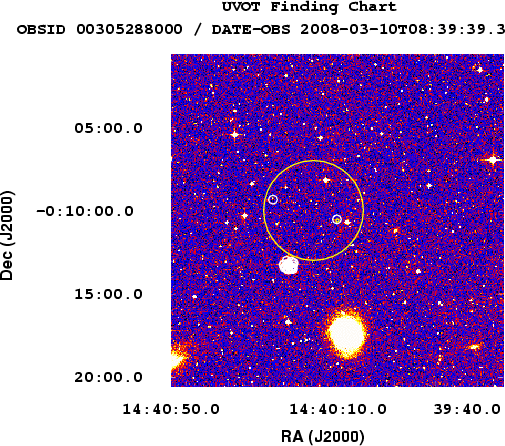
TITLE: GCN/SWIFT NOTICE
NOTICE_DATE: Mon 10 Mar 08 08:43:07 UT
NOTICE_TYPE: Swift-BAT GRB Lightcurve
TRIGGER_NUM: 305288, Seg_Num: 0
GRB_RA: 220.081d {+14h 40m 19s} (J2000),
220.186d {+14h 40m 45s} (current),
219.440d {+14h 37m 46s} (1950)
GRB_DEC: -0.166d {-00d 09' 55"} (J2000),
-0.200d {-00d 12' 00"} (current),
+0.049d {+00d 02' 55"} (1950)
GRB_DATE: 14535 TJD; 70 DOY; 08/03/10
GRB_TIME: 31078.64 SOD {08:37:58.64} UT
TRIGGER_INDEX: 137
GRB_PHI: 158.26 [deg]
GRB_THETA: 27.79 [deg]
DELTA_TIME: 32.00 [sec]
TRIGGER_DUR: 1.024 [sec]
SOLN_STATUS: 0x3
RATE_SIGNIF: 12.60 [sigma]
IMAGE_SIGNIF: 7.40 [sigma]
LC_URL: sw00305288000msb.lc
SUN_POSTN: 350.95d {+23h 23m 48s} -3.90d {-03d 54' 02"}
SUN_DIST: 130.63 [deg] Sun_angle= 8.7 [hr] (West of Sun)
MOON_POSTN: 21.93d {+01h 27m 44s} +13.91d {+13d 54' 35"}
MOON_DIST: 157.32 [deg]
MOON_ILLUM: 9 [%]
GAL_COORDS: 351.20, 52.19 [deg] galactic lon,lat of the burst (or transient)
ECL_COORDS: 217.72, 14.68 [deg] ecliptic lon,lat of the burst (or transient)
COMMENTS: SWIFT-BAT GRB Lightcurve.
COMMENTS:
COMMENTS: The next comments were copied from the BAT_POS Notice:
COMMENTS: This is a rate trigger.
COMMENTS: A point_source was found.
COMMENTS: This does not match any source in the on-board catalog.
COMMENTS: This does not match any source in the ground catalog.
COMMENTS: This is a GRB.
COMMENTS: This trigger occurred at longitude,latitude = 267.16,17.76 [deg].
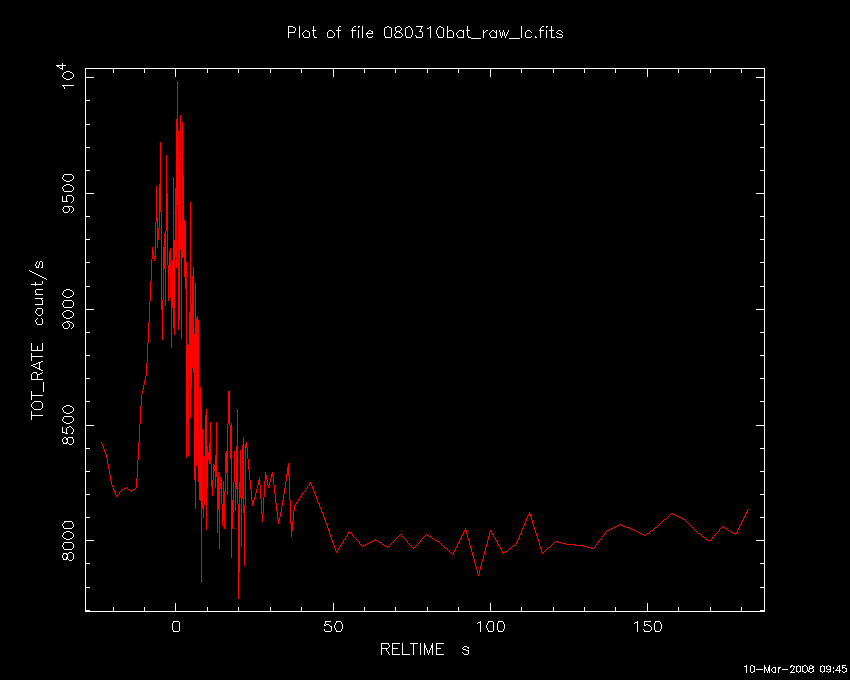
TITLE: GCN/SWIFT NOTICE
NOTICE_DATE: Mon 10 Mar 08 08:43:00 UT
NOTICE_TYPE: Swift-UVOT Image
TRIGGER_NUM: 305288, Seg_Num: 0
POINT_RA: 220.095d {+14h 40m 23s} (J2000)
POINT_DEC: -0.164d {-00d 09' 50"} (J2000)
ROLL: 95.272d
IMG_START_DATE: 14535 TJD; 70 DOY; 08/03/10
IMG_START_TIME: 31176.67 SOD {08:39:36.67} UT, 98.0 [sec] since BAT Trigger Time
FILTER: 10, White
EXPOSURE_ID: 226831179
X_OFFSET: 613 [pixels]
Y_OFFSET: 1077 [pixels]
WIDTH: 160 [pixels]
HEIGHT: 160 [pixels]
X_GRB_POS: 773
Y_GRB_POS: 1237
BINNING_INDEX: 1
IM_URL: sw00305288000msuni0098.fits
SUN_POSTN: 350.95d {+23h 23m 48s} -3.90d {-03d 54' 02"}
SUN_DIST: 130.62 [deg] Sun_angle= 8.7 [hr] (West of Sun)
MOON_POSTN: 21.93d {+01h 27m 43s} +13.91d {+13d 54' 33"}
MOON_DIST: 157.31 [deg]
MOON_ILLUM: 9 [%]
GAL_COORDS: 351.22, 52.19 [deg] galactic lon,lat of the pointing direction
ECL_COORDS: 217.74, 14.69 [deg] ecliptic lon,lat of the pointing direction
COMMENTS: SWIFT-UVOT Image.
COMMENTS: The GRB Position came from the XRT Position Command.
COMMENTS: The image has 2x2 binning (compression).
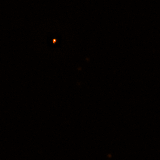
TITLE: GCN/SWIFT NOTICE
NOTICE_DATE: Mon 10 Mar 08 08:43:25 UT
NOTICE_TYPE: Swift-UVOT Processed Image
TRIGGER_NUM: 305288, Seg_Num: 0
POINT_RA: 220.095d {+14h 40m 23s} (J2000)
POINT_DEC: -0.164d {-00d 09' 50"} (J2000)
ROLL: 95.272d
IMG_START_DATE: 14535 TJD; 70 DOY; 08/03/10
IMG_START_TIME: 31176.67 SOD {08:39:36.67} UT, 98.0 [sec] since BAT Trigger Time
FILTER: 10, White
EXPOSURE_ID: 226831179
X_OFFSET: 613 [pixels]
Y_OFFSET: 1077 [pixels]
WIDTH: 160 [pixels]
HEIGHT: 160 [pixels]
X_GRB_POS: 773
Y_GRB_POS: 1237
BINNING_INDEX: 1
IM_URL: sw00305288000msuni0098.fits
SUN_POSTN: 350.95d {+23h 23m 48s} -3.90d {-03d 54' 02"}
SUN_DIST: 130.62 [deg] Sun_angle= 8.7 [hr] (West of Sun)
MOON_POSTN: 21.93d {+01h 27m 44s} +13.91d {+13d 54' 39"}
MOON_DIST: 157.31 [deg]
MOON_ILLUM: 9 [%]
GAL_COORDS: 351.22, 52.19 [deg] galactic lon,lat of the pointing direction
ECL_COORDS: 217.74, 14.69 [deg] ecliptic lon,lat of the pointing direction
COMMENTS: SWIFT-UVOT Processed Image.
COMMENTS: The GRB Position came from the XRT Position Command.
COMMENTS: The image has 2x2 binning (compression).
COMMENTS: If you have elected to receive attachments:
COMMENTS: The uvot_sources_image.fits.gz file does not exist; skipping the attachment.

TITLE: GCN/SWIFT NOTICE
NOTICE_DATE: Mon 10 Mar 08 08:49:22 UT
NOTICE_TYPE: Swift-UVOT Source List
TRIGGER_NUM: 305288, Seg_Num: 0
POINT_RA: 220.094d {+14h 40m 22s} (J2000)
POINT_DEC: -0.167d {-00d 09' 58"} (J2000)
POINT_ROLL: 95.273d
IMG_START_DATE: 14535 TJD; 70 DOY; 08/03/10
IMG_START_TIME: 31283.86 SOD {08:41:23.86} UT, 205.2 [sec] since BAT Trigger Time
FILTER: 3, V
BKG_MEAN: 1.613
N_STARS: 59
X_OFFSET: 293 [pixels]
Y_OFFSET: 757 [pixels]
X_MAX: 1252 [pixels]
Y_MAX: 1716 [pixels]
DET_THRESH: 11
PHOTO_THRESH: 5
SL_URL: sw00305288000msufc0205.fits
SUN_POSTN: 350.95d {+23h 23m 49s} -3.90d {-03d 53' 56"}
SUN_DIST: 130.62 [deg] Sun_angle= 8.7 [hr] (West of Sun)
MOON_POSTN: 21.99d {+01h 27m 58s} +13.94d {+13d 56' 09"}
MOON_DIST: 157.34 [deg]
MOON_ILLUM: 9 [%]
GAL_COORDS: 351.21, 52.19 [deg] galactic lon,lat of the pointing direction
ECL_COORDS: 217.74, 14.69 [deg] ecliptic lon,lat of the pointing direction
COMMENTS: SWIFT-UVOT Source List.
TITLE: GCN/SWIFT NOTICE
NOTICE_DATE: Mon 10 Mar 08 08:50:37 UT
NOTICE_TYPE: Swift-UVOT Image
TRIGGER_NUM: 305288, Seg_Num: 0
POINT_RA: 220.094d {+14h 40m 22s} (J2000)
POINT_DEC: -0.167d {-00d 09' 58"} (J2000)
ROLL: 95.273d
IMG_START_DATE: 14535 TJD; 70 DOY; 08/03/10
IMG_START_TIME: 31283.86 SOD {08:41:23.86} UT, 205.2 [sec] since BAT Trigger Time
FILTER: 3, V
EXPOSURE_ID: 226831286
X_OFFSET: 613 [pixels]
Y_OFFSET: 1077 [pixels]
WIDTH: 160 [pixels]
HEIGHT: 160 [pixels]
X_GRB_POS: 773
Y_GRB_POS: 1237
BINNING_INDEX: 1
IM_URL: sw00305288000msuni0205.fits
SUN_POSTN: 350.95d {+23h 23m 49s} -3.90d {-03d 53' 55"}
SUN_DIST: 130.62 [deg] Sun_angle= 8.7 [hr] (West of Sun)
MOON_POSTN: 22.00d {+01h 28m 01s} +13.94d {+13d 56' 28"}
MOON_DIST: 157.35 [deg]
MOON_ILLUM: 9 [%]
GAL_COORDS: 351.21, 52.19 [deg] galactic lon,lat of the pointing direction
ECL_COORDS: 217.74, 14.69 [deg] ecliptic lon,lat of the pointing direction
COMMENTS: SWIFT-UVOT Image.
COMMENTS: The GRB Position came from the XRT Position Command.
COMMENTS: The image has 2x2 binning (compression).
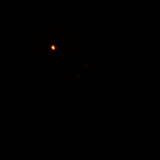
TITLE: GCN/SWIFT NOTICE
NOTICE_DATE: Mon 10 Mar 08 08:51:03 UT
NOTICE_TYPE: Swift-UVOT Processed Image
TRIGGER_NUM: 305288, Seg_Num: 0
POINT_RA: 220.094d {+14h 40m 22s} (J2000)
POINT_DEC: -0.167d {-00d 09' 58"} (J2000)
ROLL: 95.273d
IMG_START_DATE: 14535 TJD; 70 DOY; 08/03/10
IMG_START_TIME: 31283.86 SOD {08:41:23.86} UT, 205.2 [sec] since BAT Trigger Time
FILTER: 3, V
EXPOSURE_ID: 226831286
X_OFFSET: 613 [pixels]
Y_OFFSET: 1077 [pixels]
WIDTH: 160 [pixels]
HEIGHT: 160 [pixels]
X_GRB_POS: 773
Y_GRB_POS: 1237
BINNING_INDEX: 1
IM_URL: sw00305288000msuni0205.fits
SUN_POSTN: 350.95d {+23h 23m 49s} -3.90d {-03d 53' 54"}
SUN_DIST: 130.62 [deg] Sun_angle= 8.7 [hr] (West of Sun)
MOON_POSTN: 22.01d {+01h 28m 02s} +13.94d {+13d 56' 34"}
MOON_DIST: 157.35 [deg]
MOON_ILLUM: 9 [%]
GAL_COORDS: 351.21, 52.19 [deg] galactic lon,lat of the pointing direction
ECL_COORDS: 217.74, 14.69 [deg] ecliptic lon,lat of the pointing direction
COMMENTS: SWIFT-UVOT Processed Image.
COMMENTS: The GRB Position came from the XRT Position Command.
COMMENTS: The image has 2x2 binning (compression).
COMMENTS: If you have elected to receive attachments:
COMMENTS: The uvot_sources_image.fits.gz file does not exist; skipping the attachment.
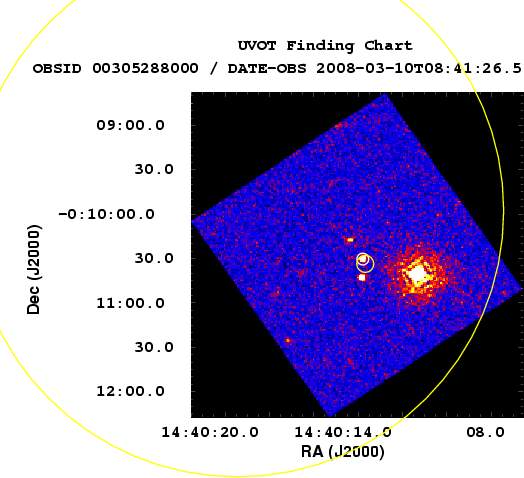
TITLE: GCN/SWIFT NOTICE
NOTICE_DATE: Mon 10 Mar 08 08:54:28 UT
NOTICE_TYPE: Swift-UVOT Source List
TRIGGER_NUM: 305288, Seg_Num: 0
POINT_RA: 220.093d {+14h 40m 22s} (J2000)
POINT_DEC: -0.167d {-00d 09' 59"} (J2000)
POINT_ROLL: 95.273d
IMG_START_DATE: 14535 TJD; 70 DOY; 08/03/10
IMG_START_TIME: 31946.22 SOD {08:52:26.22} UT, 867.6 [sec] since BAT Trigger Time
FILTER: 10, White
BKG_MEAN: 1.752
N_STARS: 53
X_OFFSET: 293 [pixels]
Y_OFFSET: 757 [pixels]
X_MAX: 1252 [pixels]
Y_MAX: 1716 [pixels]
DET_THRESH: 11
PHOTO_THRESH: 5
SL_URL: sw00305288000msufc0867.fits
SUN_POSTN: 350.96d {+23h 23m 50s} -3.90d {-03d 53' 51"}
SUN_DIST: 130.63 [deg] Sun_angle= 8.7 [hr] (West of Sun)
MOON_POSTN: 22.04d {+01h 28m 09s} +13.96d {+13d 57' 26"}
MOON_DIST: 157.37 [deg]
MOON_ILLUM: 9 [%]
GAL_COORDS: 351.21, 52.19 [deg] galactic lon,lat of the pointing direction
ECL_COORDS: 217.74, 14.69 [deg] ecliptic lon,lat of the pointing direction
COMMENTS: SWIFT-UVOT Source List.
TITLE: GCN/SWIFT NOTICE
NOTICE_DATE: Mon 10 Mar 08 08:54:57 UT
NOTICE_TYPE: Swift-UVOT Processed Source List
TRIGGER_NUM: 305288, Seg_Num: 0
POINT_RA: 220.093d {+14h 40m 22s} (J2000)
POINT_DEC: -0.167d {-00d 09' 59"} (J2000)
POINT_ROLL: 95.273d
IMG_START_DATE: 14535 TJD; 70 DOY; 08/03/10
IMG_START_TIME: 31946.22 SOD {08:52:26.22} UT, 867.6 [sec] since BAT Trigger Time
FILTER: 10, White
BKG_MEAN: 1.752
N_STARS: 53
X_OFFSET: 293 [pixels]
Y_OFFSET: 757 [pixels]
X_MAX: 1252 [pixels]
Y_MAX: 1716 [pixels]
DET_THRESH: 11
PHOTO_THRESH: 5
SL_URL: sw00305288000msufc0867.fits
SUN_POSTN: 350.96d {+23h 23m 50s} -3.90d {-03d 53' 50"}
SUN_DIST: 130.63 [deg] Sun_angle= 8.7 [hr] (West of Sun)
MOON_POSTN: 22.04d {+01h 28m 10s} +13.96d {+13d 57' 33"}
MOON_DIST: 157.37 [deg]
MOON_ILLUM: 9 [%]
GAL_COORDS: 351.21, 52.19 [deg] galactic lon,lat of the pointing direction
ECL_COORDS: 217.74, 14.69 [deg] ecliptic lon,lat of the pointing direction
COMMENTS: SWIFT-UVOT Processed Source List.
COMMENTS: All 4 attachments are included.
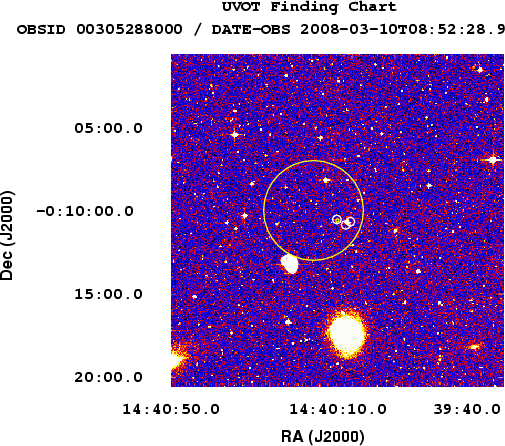
TITLE: GCN/SWIFT NOTICE
NOTICE_DATE: Mon 10 Mar 08 08:56:45 UT
NOTICE_TYPE: Swift-UVOT Image
TRIGGER_NUM: 305288, Seg_Num: 0
POINT_RA: 220.093d {+14h 40m 22s} (J2000)
POINT_DEC: -0.167d {-00d 09' 59"} (J2000)
ROLL: 95.273d
IMG_START_DATE: 14535 TJD; 70 DOY; 08/03/10
IMG_START_TIME: 31946.22 SOD {08:52:26.22} UT, 867.6 [sec] since BAT Trigger Time
FILTER: 10, White
EXPOSURE_ID: 226831948
X_OFFSET: 612 [pixels]
Y_OFFSET: 1076 [pixels]
WIDTH: 160 [pixels]
HEIGHT: 160 [pixels]
X_GRB_POS: 772
Y_GRB_POS: 1236
BINNING_INDEX: 1
IM_URL: sw00305288000msuni0867.fits
SUN_POSTN: 350.96d {+23h 23m 50s} -3.90d {-03d 53' 49"}
SUN_DIST: 130.63 [deg] Sun_angle= 8.7 [hr] (West of Sun)
MOON_POSTN: 22.06d {+01h 28m 15s} +13.97d {+13d 57' 60"}
MOON_DIST: 157.38 [deg]
MOON_ILLUM: 9 [%]
GAL_COORDS: 351.21, 52.19 [deg] galactic lon,lat of the pointing direction
ECL_COORDS: 217.74, 14.69 [deg] ecliptic lon,lat of the pointing direction
COMMENTS: SWIFT-UVOT Image.
COMMENTS: The GRB Position came from the Window Position in the Mode Command.
COMMENTS: The image has 2x2 binning (compression).
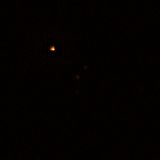
TITLE: GCN/SWIFT NOTICE
NOTICE_DATE: Mon 10 Mar 08 08:57:12 UT
NOTICE_TYPE: Swift-UVOT Processed Image
TRIGGER_NUM: 305288, Seg_Num: 0
POINT_RA: 220.093d {+14h 40m 22s} (J2000)
POINT_DEC: -0.167d {-00d 09' 59"} (J2000)
ROLL: 95.273d
IMG_START_DATE: 14535 TJD; 70 DOY; 08/03/10
IMG_START_TIME: 31946.22 SOD {08:52:26.22} UT, 867.6 [sec] since BAT Trigger Time
FILTER: 10, White
EXPOSURE_ID: 226831948
X_OFFSET: 612 [pixels]
Y_OFFSET: 1076 [pixels]
WIDTH: 160 [pixels]
HEIGHT: 160 [pixels]
X_GRB_POS: 772
Y_GRB_POS: 1236
BINNING_INDEX: 1
IM_URL: sw00305288000msuni0867.fits
SUN_POSTN: 350.96d {+23h 23m 50s} -3.90d {-03d 53' 48"}
SUN_DIST: 130.63 [deg] Sun_angle= 8.7 [hr] (West of Sun)
MOON_POSTN: 22.06d {+01h 28m 16s} +13.97d {+13d 58' 07"}
MOON_DIST: 157.38 [deg]
MOON_ILLUM: 9 [%]
GAL_COORDS: 351.21, 52.19 [deg] galactic lon,lat of the pointing direction
ECL_COORDS: 217.74, 14.69 [deg] ecliptic lon,lat of the pointing direction
COMMENTS: SWIFT-UVOT Processed Image.
COMMENTS: The GRB Position came from the Window Position in the Mode Command.
COMMENTS: The image has 2x2 binning (compression).
COMMENTS: If you have elected to receive attachments:
COMMENTS: The uvot_sources_image.fits.gz file does not exist; skipping the attachment.
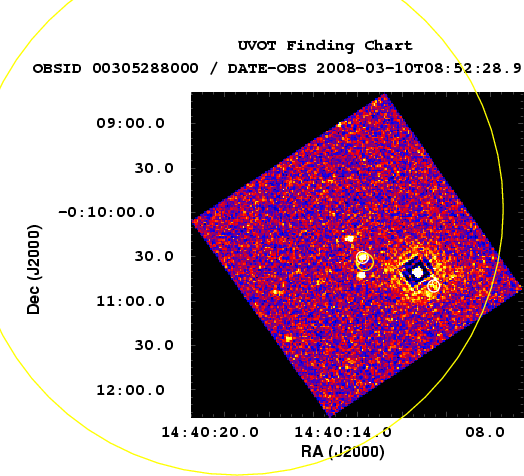
RA(J2000) = 14h 40m 19s Dec(J2000) = -00d 09' 55"with an uncertainty of 3 arcmin (radius, 90% containment, including systematic uncertainty). The BAT light curve showed a precursor at T-24 seconds and multiple peaks from T-10 to T+6 seconds. The peak count rate was ~2000 counts/sec (15-350 keV), at ~0 sec after the trigger.
RA(J2000) = 14h 40m 13.5s Dec(J2000) = -00d 10' 32.1"with an uncertainty of 5.0 arcseconds (radius, 90% containment). This location is 94 arcseconds from the BAT onboard position, within the BAT error circle. No event data are yet available to assess possible redshift constraints using X-ray spectroscopy and the nH-z relation from Grupe et al. (2007).
RA(J2000) = 14:40:13.80 = 220.0575 DEC(J2000) = -00:10:29.6 = -0.1749with a 1-sigma error radius of about 0.6 arc sec. This position is 4.1 arc sec. from the center of the XRT error circle. The estimated magnitude is 18.8 with a 1-sigma error of about 0.5 mag. No correction has been made for the expected extinction corresponding to E(B-V) of 0.04.
TITLE: GCN/SWIFT NOTICE
NOTICE_DATE: Mon 10 Mar 08 08:59:23 UT
NOTICE_TYPE: Swift-UVOT Position
TRIGGER_NUM: 305288, Seg_Num: 0
GRB_RA: 220.0575d {+14h 40m 13.80s} (J2000),
220.1625d {+14h 40m 39.00s} (current),
219.4168d {+14h 37m 40.02s} (1950)
GRB_DEC: -0.1751d {-00d 10' 30.3"} (J2000),
-0.2100d {-00d 12' 35.8"} (current),
+0.0390d {+00d 02' 20.3"} (1950)
GRB_ERROR: 0.4 [arcsec radius, statistical only]
GRB_MAG: 18.39 +/- 0.50 [mag]
FILTER: 10, White
IMG_START_DATE: 14535 TJD; 70 DOY; 08/03/10
IMG_START_TIME: 31178.00 SOD {08:39:38.00} UT, 99.4 [sec] since BAT Trigger Time
SUN_POSTN: 350.96d {+23h 23m 50s} -3.90d {-03d 53' 46"}
SUN_DIST: 130.66 [deg] Sun_angle= 8.7 [hr] (West of Sun)
MOON_POSTN: 22.09d {+01h 28m 20s} +13.98d {+13d 58' 40"}
MOON_DIST: 157.42 [deg]
MOON_ILLUM: 9 [%]
GAL_COORDS: 351.16, 52.20 [deg] galactic lon,lat of the burst (or transient)
ECL_COORDS: 217.70, 14.67 [deg] ecliptic lon,lat of the burst (or transient)
COMMENTS: SWIFT UVOT Position Notice.
COMMENTS: This Notice was ground-generated -- not flight-generated.
TITLE: GCN/SWIFT NOTICE
NOTICE_DATE: Mon 10 Mar 08 08:59:33 UT
NOTICE_TYPE: Swift-XRT Position UPDATE
TRIGGER_NUM: 305288, Seg_Num: 0
GRB_RA: 220.0580d {+14h 40m 13.9s} (J2000),
220.1630d {+14h 40m 39.1s} (current),
219.4173d {+14h 37m 40.1s} (1950)
GRB_DEC: -0.1750d {-00d 10' 29.9"} (J2000),
-0.2099d {-00d 12' 35.5"} (current),
+0.0391d {+00d 02' 20.7"} (1950)
GRB_ERROR: 2.5 [arcsec radius, statistical plus systematic, 90% containment]
GRB_INTEN: 1.00e-10 [erg/cm2/sec]
GRB_SIGNIF: 10.00 [sigma]
IMG_START_DATE: 14535 TJD; 70 DOY; 08/03/10
IMG_START_TIME: 31885.00 SOD {08:51:25.00} UT, 806.4 [sec] since BAT Trigger Time
TAM[0-3]: 100.00 100.00 100.00 100.00
AMPLIFIER: 1
WAVEFORM: 31
SUN_POSTN: 350.96d {+23h 23m 50s} -3.90d {-03d 53' 46"}
SUN_DIST: 130.66 [deg] Sun_angle= 8.7 [hr] (West of Sun)
MOON_POSTN: 22.09d {+01h 28m 21s} +13.98d {+13d 58' 42"}
MOON_DIST: 157.42 [deg]
MOON_ILLUM: 9 [%]
GAL_COORDS: 351.16, 52.20 [deg] galactic lon,lat of the burst
ECL_COORDS: 217.71, 14.67 [deg] ecliptic lon,lat of the burst
COMMENTS: SWIFT-XRT Coordinates.
COMMENTS: This Notice was ground-generated -- not flight-generated.
COMMENTS: This is an Update Notice -- the RA,Dec values herein supersede the previous XRT_POS Notice.
COMMENTS: TAM values, flux and significance fields are not valid
COMMENTS: This position was automatically generated on the ground using
COMMENTS: Photon Counting data telemetered via TDRSS (SPER data).
COMMENTS: See http://www.swift.ac.uk/sper/docs.php for details.
COMMENTS: This position was enhanced using UVOT field astrometry
TITLE: GCN/SWIFT NOTICE
NOTICE_DATE: Mon 10 Mar 08 09:01:23 UT
NOTICE_TYPE: Swift-UVOT Source List
TRIGGER_NUM: 305288, Seg_Num: 0
POINT_RA: 220.093d {+14h 40m 22s} (J2000)
POINT_DEC: -0.167d {-00d 10' 00"} (J2000)
POINT_ROLL: 95.273d
IMG_START_DATE: 14535 TJD; 70 DOY; 08/03/10
IMG_START_TIME: 32053.29 SOD {08:54:13.29} UT, 974.7 [sec] since BAT Trigger Time
FILTER: 3, V
BKG_MEAN: 2.362
N_STARS: 54
X_OFFSET: 293 [pixels]
Y_OFFSET: 757 [pixels]
X_MAX: 1252 [pixels]
Y_MAX: 1716 [pixels]
DET_THRESH: 13
PHOTO_THRESH: 7
SL_URL: sw00305288000msufc0974.fits
SUN_POSTN: 350.96d {+23h 23m 51s} -3.90d {-03d 53' 44"}
SUN_DIST: 130.63 [deg] Sun_angle= 8.7 [hr] (West of Sun)
MOON_POSTN: 22.10d {+01h 28m 25s} +13.99d {+13d 59' 10"}
MOON_DIST: 157.40 [deg]
MOON_ILLUM: 9 [%]
GAL_COORDS: 351.21, 52.19 [deg] galactic lon,lat of the pointing direction
ECL_COORDS: 217.74, 14.69 [deg] ecliptic lon,lat of the pointing direction
COMMENTS: SWIFT-UVOT Source List.
TITLE: GCN/SWIFT NOTICE
NOTICE_DATE: Mon 10 Mar 08 09:01:50 UT
NOTICE_TYPE: Swift-UVOT Processed Source List
TRIGGER_NUM: 305288, Seg_Num: 0
POINT_RA: 220.093d {+14h 40m 22s} (J2000)
POINT_DEC: -0.167d {-00d 10' 00"} (J2000)
POINT_ROLL: 95.273d
IMG_START_DATE: 14535 TJD; 70 DOY; 08/03/10
IMG_START_TIME: 32053.29 SOD {08:54:13.29} UT, 974.7 [sec] since BAT Trigger Time
FILTER: 3, V
BKG_MEAN: 2.362
N_STARS: 54
X_OFFSET: 293 [pixels]
Y_OFFSET: 757 [pixels]
X_MAX: 1252 [pixels]
Y_MAX: 1716 [pixels]
DET_THRESH: 13
PHOTO_THRESH: 7
SL_URL: sw00305288000msufc0974.fits
SUN_POSTN: 350.96d {+23h 23m 51s} -3.90d {-03d 53' 44"}
SUN_DIST: 130.63 [deg] Sun_angle= 8.7 [hr] (West of Sun)
MOON_POSTN: 22.11d {+01h 28m 26s} +13.99d {+13d 59' 16"}
MOON_DIST: 157.40 [deg]
MOON_ILLUM: 9 [%]
GAL_COORDS: 351.21, 52.19 [deg] galactic lon,lat of the pointing direction
ECL_COORDS: 217.74, 14.69 [deg] ecliptic lon,lat of the pointing direction
COMMENTS: SWIFT-UVOT Processed Source List.
COMMENTS: All 4 attachments are included.
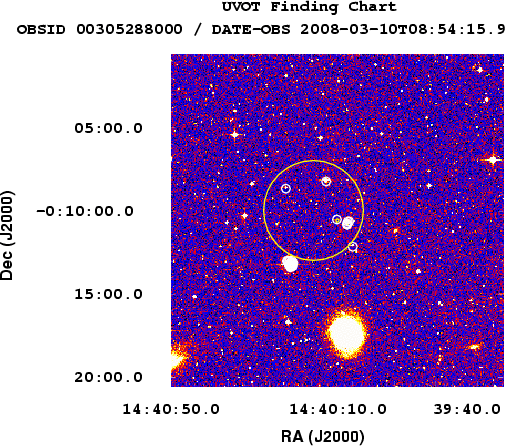
TITLE: GCN/SWIFT NOTICE
NOTICE_DATE: Mon 10 Mar 08 09:02:55 UT
NOTICE_TYPE: Swift-UVOT Image
TRIGGER_NUM: 305288, Seg_Num: 0
POINT_RA: 220.093d {+14h 40m 22s} (J2000)
POINT_DEC: -0.167d {-00d 10' 00"} (J2000)
ROLL: 95.273d
IMG_START_DATE: 14535 TJD; 70 DOY; 08/03/10
IMG_START_TIME: 32053.29 SOD {08:54:13.29} UT, 974.7 [sec] since BAT Trigger Time
FILTER: 3, V
EXPOSURE_ID: 226832055
X_OFFSET: 612 [pixels]
Y_OFFSET: 1076 [pixels]
WIDTH: 160 [pixels]
HEIGHT: 160 [pixels]
X_GRB_POS: 772
Y_GRB_POS: 1236
BINNING_INDEX: 1
IM_URL: sw00305288000msuni0974.fits
SUN_POSTN: 350.96d {+23h 23m 51s} -3.90d {-03d 53' 42"}
SUN_DIST: 130.63 [deg] Sun_angle= 8.7 [hr] (West of Sun)
MOON_POSTN: 22.12d {+01h 28m 28s} +13.99d {+13d 59' 33"}
MOON_DIST: 157.41 [deg]
MOON_ILLUM: 9 [%]
GAL_COORDS: 351.21, 52.19 [deg] galactic lon,lat of the pointing direction
ECL_COORDS: 217.74, 14.69 [deg] ecliptic lon,lat of the pointing direction
COMMENTS: SWIFT-UVOT Image.
COMMENTS: The GRB Position came from the Window Position in the Mode Command.
COMMENTS: The image has 2x2 binning (compression).
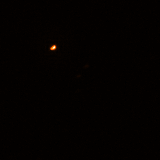
TITLE: GCN/SWIFT NOTICE
NOTICE_DATE: Mon 10 Mar 08 09:03:23 UT
NOTICE_TYPE: Swift-UVOT Processed Image
TRIGGER_NUM: 305288, Seg_Num: 0
POINT_RA: 220.093d {+14h 40m 22s} (J2000)
POINT_DEC: -0.167d {-00d 10' 00"} (J2000)
ROLL: 95.273d
IMG_START_DATE: 14535 TJD; 70 DOY; 08/03/10
IMG_START_TIME: 32053.29 SOD {08:54:13.29} UT, 974.7 [sec] since BAT Trigger Time
FILTER: 3, V
EXPOSURE_ID: 226832055
X_OFFSET: 612 [pixels]
Y_OFFSET: 1076 [pixels]
WIDTH: 160 [pixels]
HEIGHT: 160 [pixels]
X_GRB_POS: 772
Y_GRB_POS: 1236
BINNING_INDEX: 1
IM_URL: sw00305288000msuni0974.fits
SUN_POSTN: 350.96d {+23h 23m 51s} -3.90d {-03d 53' 42"}
SUN_DIST: 130.63 [deg] Sun_angle= 8.7 [hr] (West of Sun)
MOON_POSTN: 22.12d {+01h 28m 29s} +13.99d {+13d 59' 40"}
MOON_DIST: 157.41 [deg]
MOON_ILLUM: 9 [%]
GAL_COORDS: 351.21, 52.19 [deg] galactic lon,lat of the pointing direction
ECL_COORDS: 217.74, 14.69 [deg] ecliptic lon,lat of the pointing direction
COMMENTS: SWIFT-UVOT Processed Image.
COMMENTS: The GRB Position came from the Window Position in the Mode Command.
COMMENTS: The image has 2x2 binning (compression).
COMMENTS: If you have elected to receive attachments:
COMMENTS: The uvot_sources_image.fits.gz file does not exist; skipping the attachment.
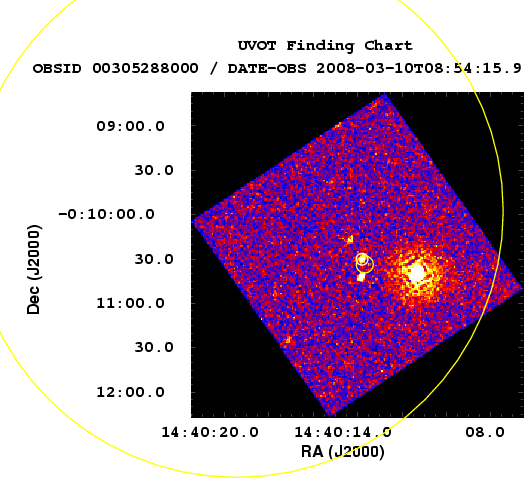
time post-burst I mag J mag ~25 minutes 16.3+/-0.2 15.9+/-0.2The afterglow fades by ~0.4 magnitudes in I between 25 and 45 minutes post-burst. This source is therefore confirmed to be the afterglow of GRB 080310, with a decay rate of alpha ~ -0.6.
UT Start UT End ExpTime R mag error Single 08:40:29 08:41:09 1x20s 17.97 +/- 0.18 08:41:03 08:41:23 1x20s 16.81 +/- 0.08 Stack 08:40:29 08:42:37 5x20s 16.91 +/- 0.04 08:43:24 08:54:27 10x60s 16.98 +/- 0.02Observations are continuing. This message can be cited.
TITLE: GCN/SWIFT NOTICE
NOTICE_DATE: Mon 10 Mar 08 08:49:48 UT
NOTICE_TYPE: Swift-UVOT Processed Source List
TRIGGER_NUM: 305288, Seg_Num: 0
POINT_RA: 220.094d {+14h 40m 22s} (J2000)
POINT_DEC: -0.167d {-00d 09' 58"} (J2000)
POINT_ROLL: 95.273d
IMG_START_DATE: 14535 TJD; 70 DOY; 08/03/10
IMG_START_TIME: 31283.86 SOD {08:41:23.86} UT, 205.2 [sec] since BAT Trigger Time
FILTER: 3, V
BKG_MEAN: 1.613
N_STARS: 59
X_OFFSET: 293 [pixels]
Y_OFFSET: 757 [pixels]
X_MAX: 1252 [pixels]
Y_MAX: 1716 [pixels]
DET_THRESH: 11
PHOTO_THRESH: 5
SL_URL: sw00305288000msufc0205.fits
SUN_POSTN: 350.95d {+23h 23m 49s} -3.90d {-03d 53' 55"}
SUN_DIST: 130.62 [deg] Sun_angle= 8.7 [hr] (West of Sun)
MOON_POSTN: 22.00d {+01h 27m 59s} +13.94d {+13d 56' 15"}
MOON_DIST: 157.34 [deg]
MOON_ILLUM: 9 [%]
GAL_COORDS: 351.21, 52.19 [deg] galactic lon,lat of the pointing direction
ECL_COORDS: 217.74, 14.69 [deg] ecliptic lon,lat of the pointing direction
COMMENTS: SWIFT-UVOT Processed Source List.
COMMENTS: All 4 attachments are included.
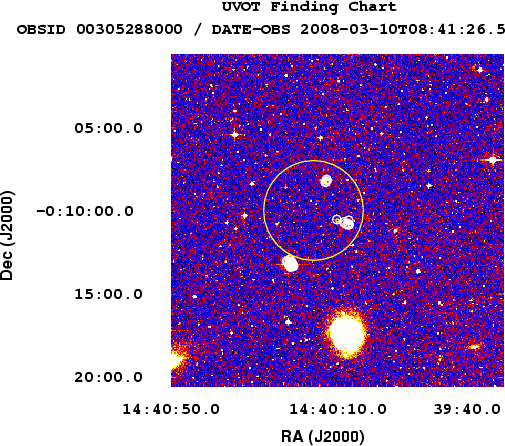
RA (J2000): 14h 40m 13.92s Dec (J2000): -00d 10' 29.9"with an uncertainty of 1.8 arcsec (radius, 90% confidence).
Filter T_start(s) T_stop(s) Exposure(s) Mag white 99 197 98 18.50 +/- 0.06 white 868 967 98 17.95 +/- 0.05 white 6788 6985 197 18.99 +/- 0.07 v 208 602 393 17.38 +/- 0.05 v 7199 7334 135 18.5 +/- 0.3 b 685 695 10 17.7 +/- 0.2 b 6584 6780 197 18.9 +/- 0.1 u 660 680 19 17.8 +/- 0.2 u 1430 1450 19 17.3 +/- 0.2 u 6379 6575 197 18.3 +/- 0.1 uvw1 638 6373 452 20.3 +/- 0.3 uvm2 613 6168 197 >19.8 uvw2 716 7194 432 >20.8No correction has been made for the expected Galactic extinction of E (B-V) of 0.04 mag in the direction of the burst (Schlegel, et al. 1998).
RA(J2000) = 14h 40m 9.6s Dec(J2000) = 0d 9' 49"with an uncertainty of 1.4 arcmin, (radius, sys+stat, 90% containment). The partial coding was 68%.
t_mid(s) exp(s) magnitude 1833 259 J = 15.63 +/- 0.03 1833 259 H = 14.94 +/- 0.03 1833 259 K = 14.29 +/- 0.03Combining PAIRITEL data with 347 KAIT observations (calibrated to SDSS DR6) and the UVOT magnitudes reported by Hoversten et al. (GCN 7398), we generate a UV-through-IR spectral energy distribution interpolated to the midpoint of the PAIRITEL observations. The SED is well-fit by an intrinsic power-law spectral index of beta ~ 0.6 with a small amount (A_V = 0.10 +/- 0.05) of SMC-like host-galaxy extinction:
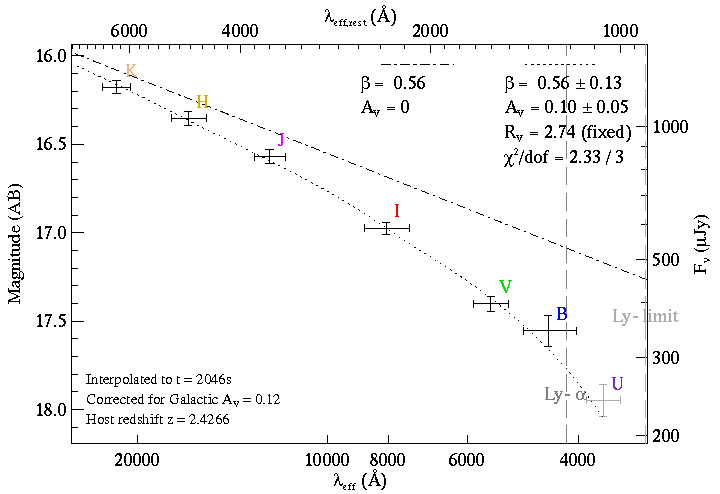
* The University of Arizona on behalf of the Arizona university system * Istituto Nazionale di Astrofisica, Italy * LBT Beteiligungsgesellschaft, Germany, representing the Max Planck Society, the Astrophysical Institute Potsdam, and Heidelberg University * The Ohio State University * The Research Corporation, on behalf of The University of Notre Dame, University of Minnesota and University of VirginiaThis message may be cited.
mid-UT exp-T g' Rc Ic ------------------------------------------------------------ 15:09:46 60min 20.0+-0.2 19.7+-0.3 19.1+-0.2 16:24:47 60min 20.4+-0.2 20.2+-0.2 19.5+-0.2 17:39:46 60min 20.6+-0.1 20.4+-0.2 19.8+-0.2 18:54:44 60min 20.6+-0.2 20.5+-0.1 20.2+-0.3 19:57:05 42min 20.6+-0.2 20.3+-0.1 20.0+-0.2 ------------------------------------------------------------
Start_UT End_UT mag magerror mlim(of image) --------------------------------------------------------------- 09:03:03.4 09:07:31.2 17.2 0.1 18.4 09:56:17.5 10:09:49.8 18.0 0.1 19.4
The LBT is an international collaboration among institutions in the United States, Italy and Germany. The LBT Corporation partners are: * The University of Arizona on behalf of the Arizona university system * Istituto Nazionale di Astrofisica, Italy * LBT Beteiligungsgesellschaft, Germany, representing the Max Planck Society, the Astrophysical Institute Potsdam, and Heidelberg University * The Ohio State University * The Research Corporation, on behalf of The University of Notre Dame, University of Minnesota and University of VirginiaThis message may be cited.
mid-UT exp Rc ----------------------------------- 15:18:50 5 x 3-min 20.1+-0.1 18:09:42 5 x 3-min 20.5+-0.1 -----------------------------------
age (days) r mag error telescope 3.04 22.45 0.05 LBT 4.03 23.10 0.10 MDMThe photometry indicates that the afterglow has resumed a steep decline. Including LBT photometry from March 12 (Garnavich et al., GCN 7414), we estimate a power-law decline index of 2.1 between 2 and 4 days after the burst.
* The University of Arizona on behalf of the Arizona university system * Istituto Nazionale di Astrofisica, Italy * LBT Beteiligungsgesellschaft, Germany, representing the Max Planck Society, the Astrophysical Institute Potsdam, and Heidelberg University * The Ohio State University * The Research Corporation, on behalf of The University of Notre Dame, University of Minnesota and University of VirginiaThis message may be cited.
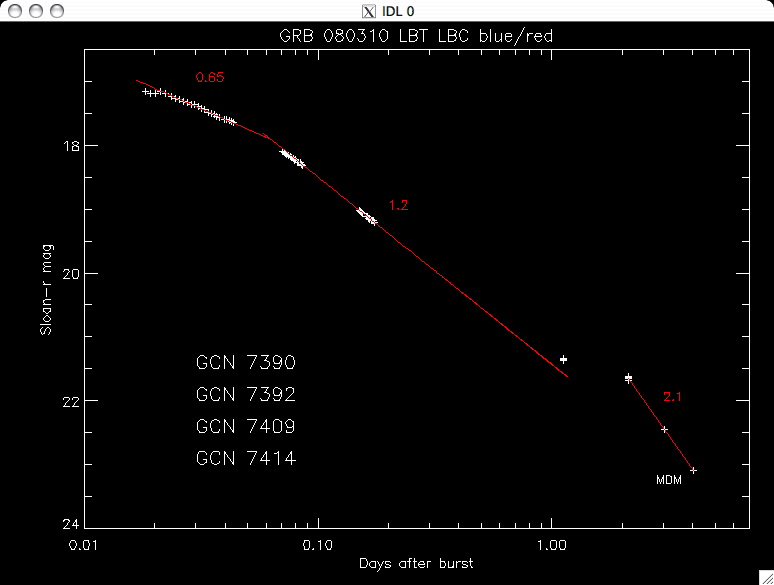
* The University of Arizona on behalf of the Arizona university system * Istituto Nazionale di Astrofisica, Italy * LBT Beteiligungsgesellschaft, Germany, representing the Max Planck Society, the Astrophysical Institute Potsdam, and Heidelberg University * The Ohio State University * The Research Corporation, on behalf of The University of Notre Dame, University of Minnesota and University of VirginiaThis message may be cited.